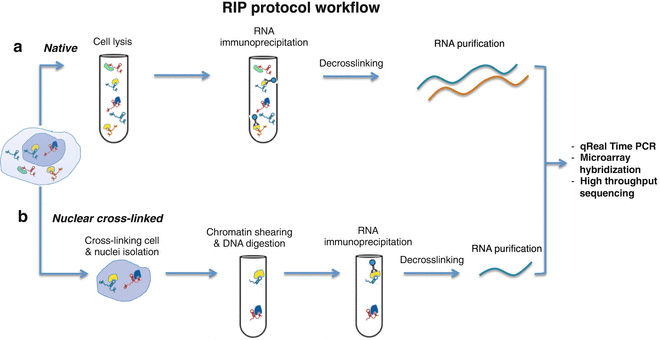RNA binding protein mapping: RIP, CLIP, HITS-CLIP, PAR-CLIP
Back to index
[Stefano Romanazzi]
RNA IMMUNOPRECIPITATION (RIP)
This technique is very similar to ChIP: a specific antibody is used to pull down the RNA binding proteins(RBP) together with their associated RNA, it can be used both for mRNA and non-coding RNA; isolated RNA can then be futher analyzed with other techniques, like RT-PCR or sequencing.
There are two main RIP variants:
Native RIP: direct identification of the bound RNA and the protein of interest in the immunoprecipitated sample, this approach typically allows recovery of high affinity protein-RNA interactions
Cross-linked RIP: live cells are treated with formaldehyde first, to generate RNA-proteins cross-links, this allows precise mapping of the direct and indirect binding site of the protein to the RNA
PROTOCOL SUMMARY
1. Cell harvesting (and optional treatment with formaldehyde)
2. Nuclei isolation
3. Chromatin shearing
4. RNA immunoprecipitation
5. Washing off unbound material
6. Purification of RNA that was bound to immunoprecipitated RBP
UV cross-linking and immunoprecipitation (CLIP):
CLIP is an antibody-based technique used to study RNA-protein interactions related to RNA immunoprecipitation (RIP) but differs from RIP in the use of UV radiation to cross-link RNA binding proteins to the RNA that they are bound to. This covalent bond is irreversible, allowing stringent purification conditions. Unlike RIP, CLIP provides information about the actual protein binding site on the RNA.
Different types of CLIP exist, high-throughput sequencing-CLIP (HITS-CLIP), photoactivatable-ribonucleoside enhanced CLIP (PAR-CLIP), and individual CLIP (iCLIP).
CLIP protocol:
1. UV cross linking of tissue culture cells.
2. Cell lysis and partail RNA digestion.
3. Immunoprecipitation and dephosphorylation of RNA 3' ends.
4. Linker ligation to RNA 3' ends and RNA 5' end labeling.
5. Linker SDS-PAGE and membrane transfer.
6. RNA isolation.
7. Reverse transcription.
8. Gel purification of cDNA.
9. Ligation of primer to the 5' end of the cDNA.
10. PCR amplification.
11. Linker and primer sequences.
[https://www.abcam.com/protocols/uv-cross-linking-and-immunoprecipitation-clip]
(Eiman Elsayed)